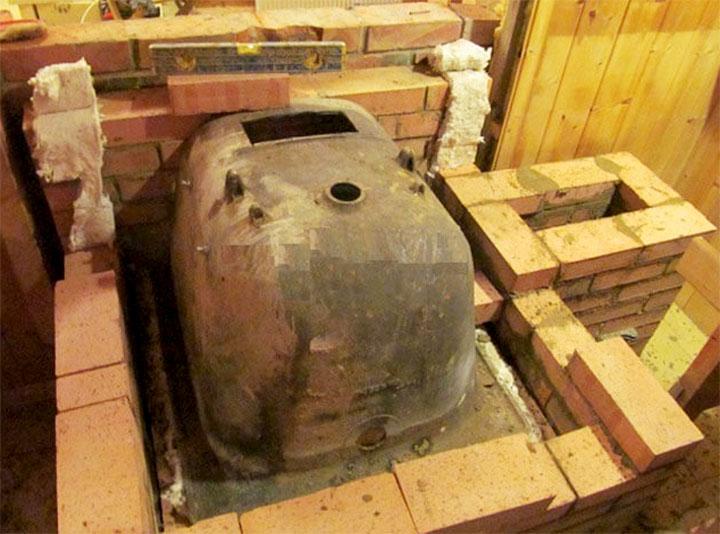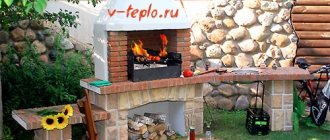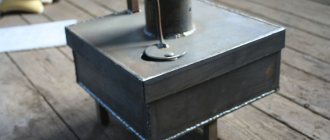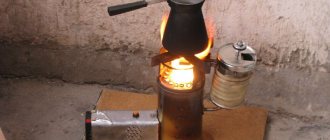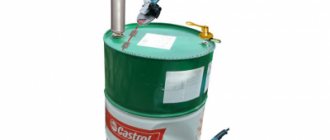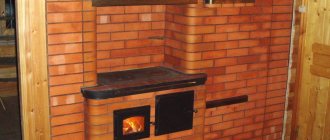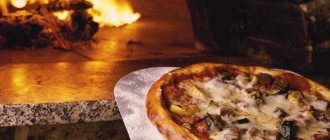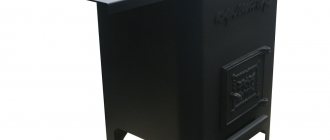Necessary equipment and materials for work

Welding machine
Building a stove from a cast-iron bathroom with your own hands will require the use of the following tools:
- Angle grinder (grinder);
- Cutting and cleaning discs for angle grinders;
- Electric drill, drills;
- Pliers, wrenches;
- If available - equipment for gas cutting of metal;
- Opening tools - shovels, scrap;
- A hammer;
- Trowel, spatula;
- Capacity for solution preparation;
- Measuring tool - tape measure, plumb line, metal corner, building level;
- Welding machine for chimney installation, mask, electrodes;
- Hacksaw for wood (for the construction of formwork).
The beginning of construction presupposes the presence of a cast-iron bath. The stove from the bath has a foundation, since the total weight of the structure takes on a decent value. In addition to the bathroom, you will need the following materials:
- Cement;
- Sand;
- Red brick;
- Water;
- Clay;
- Metal sheet with a thickness of 4 mm;
- Metal corner;
- A home-made or factory-made grille of the appropriate size;
- Metal and door hinges;
- Chimney pipe with a wall thickness of at least 3.5 mm, a diameter of 100 - 125 mm, a length of 2.5 - 3 meters;
- Foundation waterproofing material - polyethylene film;
- Rabitz;
- Boards 20 - 25 mm thick, nails, slats 20x20 mm.
List of required materials
Several items made of cast iron (if not, then stainless steel is also suitable):
- "old school" cast iron bath;
- grate;
- a stove with burners or a metal sheet (5 mm and thicker);
- door (beautiful forged or just typical).
Of the metal elements, corners are needed to fix the grate, fastening bolts with nuts, a chain-link mesh to strengthen the clay layer, a pipe for making a chimney (diameter from 100 mm to 120 mm).
Finished oven doors
The masonry is made of refractory bricks, fastening the rows with clay-sand mortar. The number of bricks depends on the size of the structure. If the external finishing of the device with ceramics is planned, then you should purchase tiles and heat-resistant glue, as well as a heat-resistant sealant. Do not forget about protective equipment - tight clothing, goggles or a mask, work gloves.
Cast iron bath cutting


Cast iron bath cutting
The first stage of construction is cutting the old bathroom across into two equal parts. This operation is performed using a grinder. First, the cutting line is marked - the line is applied with a marker on the enamel or with chalk on the outside of the bowl. Cutting is best done on the outside of the bowl, but if this is not possible, you can cut along the inside.
Cutting cast iron products is a long and laborious job. For this work, a professional tool is used, in the absence of one, it is necessary to take breaks from work, otherwise the grinder may burn out.
When working, it is necessary to comply with safety conditions. It is better to put on a protective mask on your face, otherwise the smallest particles of enamel can get into your eyes. When cutting cast iron, a large amount of dust is generated - breathing must be protected with a gauze bandage or a respirator. The room where the work is carried out must be isolated from adjacent rooms - dust removal will subsequently cause serious difficulties.
When cutting the bowl, the bath must be fixed so that it does not pinch the grinder's disc. Broken disc fragments during operation can cause injury. It takes an average of 45-60 minutes to cut a bathroom (excluding breaks). The speed of work always depends on the level of proficiency in the tool.
It is necessary to take into account the structure of cast iron - it has low impact strength.Therefore, it is impossible to apply strong blows, to strongly load the bath with mechanical forces.
Furnace installation
A stove from an old bathtub, located in a summer cottage or land plot of a private house, consists of three main parts:
- Firebox from an old bathroom;
- Furnace foundation;
- Brickwork, cladding.
After preparing the bathroom (cutting into two equal parts), they begin to build the foundation.
Foundation construction
With the help of pegs and a cord, they mark the future foundation. The foundation is made of concrete mortar or brickwork.
First, a rectangular trench is torn off, its depth should be at least 500 mm. A layer of sand and gravel is laid at the bottom of the trench, the layers are compacted. A layer of waterproofing is laid on top of the pillow - usually a plastic wrap. In the central part, a formwork is being built to raise the base of the foundation under the firebox. Most often, a general formwork is simply constructed and the foundation is poured to a height of at least 250 - 300 mm from the ground level.
The free volume is reinforced and filled with a solution of cement and sand in a ratio of 1 measure of cement to 3 measures of sand. Otherwise, the volume is filled with brickwork.
After completing the work on the construction of the foundation, he is given time for a quality solidification.
Assembly work
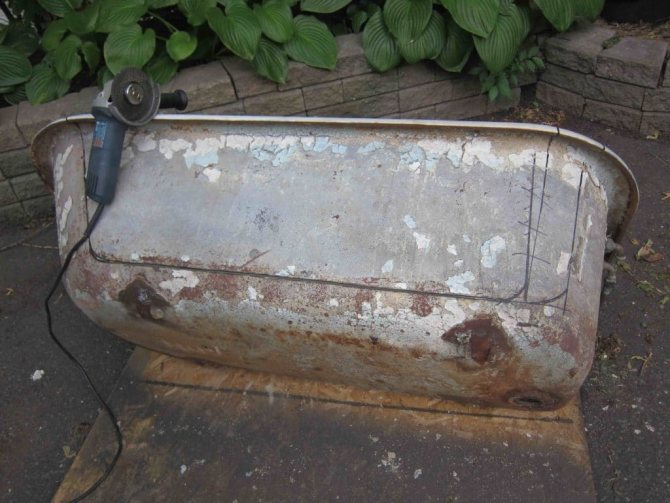

Assembling the oven from the bath
After the foundation has solidified, assembly work is started. The first half of the bowl is installed on the base of the foundation (without drain holes). On top of the reversal of the bowl, a sheet of metal cut according to the bathroom template is laid on a heat-resistant sealant.
Holes are sometimes cut into the sheet for use as a hob.
A hole is cut in the overlap sheet, corresponding to the diameter of the selected chimney pipe. The pipe is welded to the floor sheet using electric arc welding.
The second half of the bathroom is laid on the floor sheet. The joint is pre-laid with a heat-resistant sealant, instead of the drain (bottom) hole, a passage for the chimney is cut. First, a hole is marked along the section of the pipe used, then holes are drilled according to the marking. It is dangerous to knock out a drilled element - cast iron is fragile - therefore, the holes are connected by the slots of the grinder.
Holes are drilled along the perimeter of the joint of two hemispheres of the bathroom, the joint is tightened with M10 or M12 bolts. The fasteners are installed with a step of 150-200 mm. When tightening the bolts, you do not need to exert excessive force - the cast iron may burst. In the lower hemisphere at a height of 15 cm from the lowest point of the vault, supports for the grate are bolted. The installation of supports is mandatory, otherwise, when the grate moves, the burning firewood will fall into the lower part of the furnace and the quality of combustion will be disturbed. The main work on the construction of the furnace has been completed.
The front part of the firebox is equipped in two ways - from metal and into brickwork. In the case of using a sheet of metal, it is marked and cut to the appropriate size with a grinder. It is fastened to the split end of the furnace through metal corners attached to the bowl and the sheet through the holes with bolts. In the plane of the sheet, openings are cut out for the small (lower) blower door and the large upper furnace door (used for loading fuel). Doors are usually installed on welded hinges.
The cost of metal and the amount of work with such an implementation of the front part of the furnace exceed the option of installing brickwork. When laying from the end of the firebox, mortgages and openings are left in it for installing doors.
After assembling the front part, the lower hemisphere of the furnace is lined with bricks. First, the first angle is displayed (along the plumb line), then the laying is continued along the perimeter of the firebox.
After the masonry has solidified, work begins on the thermal insulation of the upper hemisphere. For this, a chain-link mesh is laid on it.The mesh should fit snugly to the surface of the firebox - for this, it is fixed to the brickwork along the perimeter. The chain-link serves as a frame, a supporting structure for a layer of clay. The first layer of a previously prepared medium viscosity clay solution is tightly hammered into the mesh. After partial hardening, a final clay layer is applied and leveled.
The clay should harden - it must be covered from precipitation with a film, without restricting air access. After hardening, the clay is most often covered with several layers of lime whitewash.
A fungus must be installed on the chimney pipe to protect it from precipitation.
Some craftsmen recommend using cast iron baths for building a sauna stove. Moreover, the cast-iron bath acts as the basis of the stove and at the same time serves as the upper arch of the firebox; ice water can be splashed on it in a hot state. In this case, cast iron can crack. To make a stove for a bath from a cast iron bath - count on some luck, not know the properties of cast iron.
Benefits of using cast iron
Why is a homemade cast iron stove (in our case, a cast iron bath stove) so beneficial? Cast iron is one of the best materials for this purpose, but factory made cast iron furnaces are quite expensive. This material gained popularity due to its strength, although it is fragile. In addition, it is resistant to critically high temperatures and is unpretentious in operation.
Modern cast iron stoves are especially popular
Comparing cast iron and brick ovens, let's say that the thermal conductivity is much better in the former. And since the high temperature is not constantly maintained in the bath, the material should not be sensitive to temperature extremes.
In winter, the bathhouse in the summer cottage is usually not heated, which is why the brick sometimes begins to crumble, while cast iron is not aware of such problems. As for fire safety, only a new brick oven is absolutely not dangerous. With an old product, sparks can burst through cracks.
In order to enhance the aesthetics, a do-it-yourself cast-iron bath stove is best lined with bricks. If some units are damaged, they can be easily replaced.
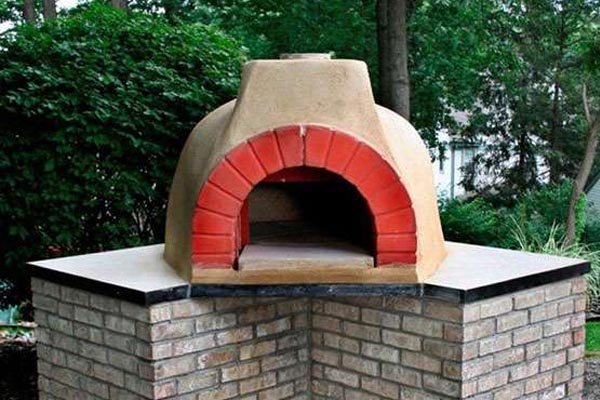

Steel competes with cast iron. In terms of heating rate and strength, steel furnaces are not inferior to cast iron ones, however, the service life of the former is significantly shorter. Perhaps the main weak point of steel furnaces is their susceptibility to corrosion. In cast iron, this problem is not so pronounced.
Having made a stove from a cast-iron bath, you will become the owner of a convenient and reliable device that functions perfectly in any conditions. From such a bath, you can also make a very original fireplace for a summer residence. It is especially suitable for those who are now laying out the laying of a country house, since the fireplace is, as it were, "recessed" into a brick wall, and this makes it possible to use the space with maximum benefit.
Cast iron parts are valuable in the manufacture of heating devices for two reasons:
- the metal heats up quickly and retains heat for a long time;
- despite the sharp changes in temperature, cast iron does not wear out and serves for decades.
Even the enamel, which is used to cover the plumbing fixtures, retains its qualities and does not burn out immediately. The fact is that the technology of applying a layer of enamel in the last century assumed heating the finished product to 800 ° C. The quartz sand, which is part of the solution, melted under the action of high temperature and contributed to the baking of the enamel.
An old cast iron bathtub - the main element of a garden stove
The concave shape of the product is also suitable for the device of the brazier. It resembles a dome, which can serve as both the base of the oven and the compartment of the combustion chamber.So, if you want to build an original barbecue oven from an old bath with your own hands, arm yourself with tools and get down to business.
We warn you right away that the cutting process is a laborious task that requires effort, endurance and certain knowledge. Everyone who has previously worked with a grinder knows the technology of cutting thick metal sheets, but here is a special case: the base material is covered with a thick (about 2 mm) layer of enamel. Therefore, you need to cut carefully, slowly, in sections of 5-10 cm, pausing to cool the disc.
Half of the sawn tub
The ideal place for cutting is the street. If the procedure takes place indoors, it is necessary to protect the surrounding objects, since cast iron dust can ruin good things. It is better if the container lies upside down - it is easier to make a straight cut this way.
- practically unlimited service life. Even the enamel that was used to cover the bathtubs is practically very difficult to destroy. This can be explained quite simply. In Soviet times, the enamel coating was made in two layers using quartz sand, which, when baked, formed a super-strong composition;
- a significant indicator of heat capacity, as well as the accumulation and release of heat;
- high resistance to corrosion.
External facade decoration
The external design of the stove depends on the wishes of the owner. The masonry can be plastered and painted, various decorative mosaics and natural stone are applied to it. Decorating the structure is not always necessary - the stove from the bathroom will always look like an amazing structure on the site.
The construction of a stove from an old cast-iron bathroom is an event that requires equipment and some skills in carrying out installation work. But the construction of the stove is worth it - it has an excellent design and will serve its owner for many years, surprising with culinary delights and decorating the estate.
What is the foundation for
Having cut the main part of the future stove into two identical fragments, you can start building the foundation. It is the main stabilizing element of the structure. Without a solid cement foundation, regular shrinkage will occur (do not forget about the weight of the metal) into the soil, which can render brickwork unusable.
The technology for constructing a concrete base can be different. A small stand can be built without additional supports; to build a high one, you will have to put together a blind area. The main purpose of the blind area is to give the concrete base an even shape.
Diagram of the device of a concrete foundation with a blind area
